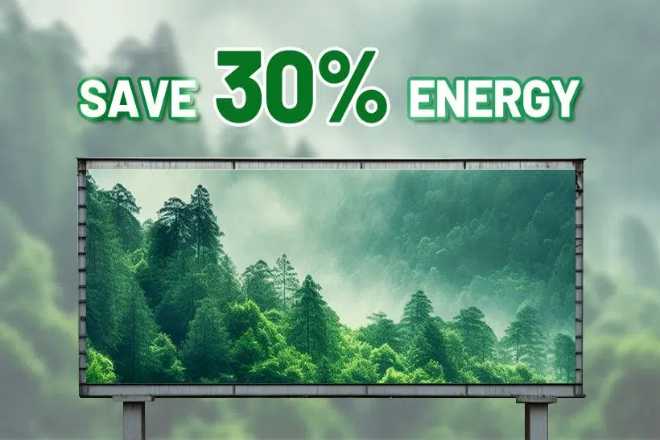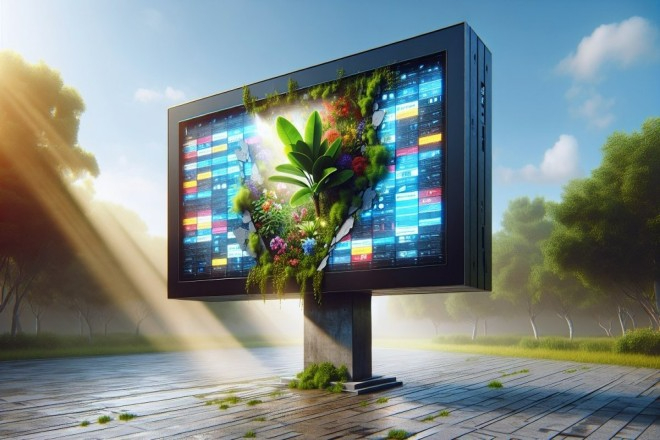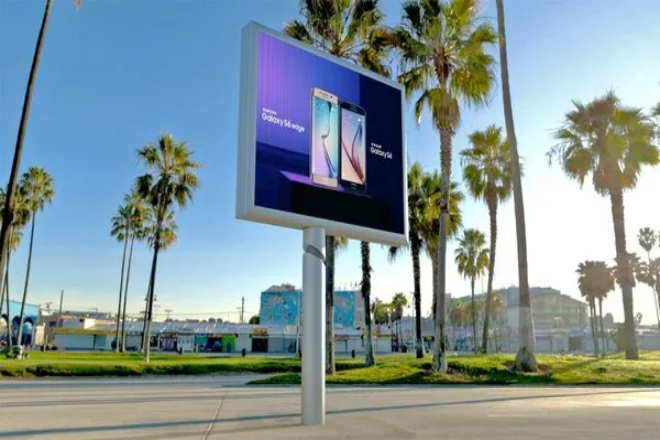مقدمة

In today’s era of rapid technological development, شاشات عرض LED are widely used in various fields with their unique charm, from commercial advertising to home entertainment, from outdoor large LED screens ل شاشات LED داخلية, and are everywhere.
However, with the increasing awareness of environmental protection, people have begun to pay more attention to the environmental performance of technological products. So, will LED display screens become more and more environmentally friendly?
1. Analysis of the current status of the environmental protection advantages of LED display screens
In today’s era of increasing environmental awareness, LED display screens have stood out in the field of display technology with their unique environmental protection advantages.
Next, let’s talk in detail about the environmental protection advantages of LED display screens in terms of energy-saving characteristics, long-life, low maintenance costs, and recyclability.
1). Energy-saving characteristics
When it comes to LED display screens, we have to mention their energy-saving characteristics. LED, as a semiconductor light source, has a working principle that determines its low energy consumption.
Compared with traditional LCD and CRT display screens, LED display screens have much lower energy consumption at the same brightness.
This is because the energy conversion efficiency of LED light sources is particularly high, and most of the electrical energy can be converted into light energy instead of a large part of the electrical energy being wasted as heat energy like traditional light sources.
For example, you may have had this experience: you watched an LCD TV at home for an afternoon, and the electricity bill went up. But if you use an LED display, the electricity bill may not be so scary.
This is because LED displays are more energy-efficient than LCD TVs. Moreover, the brightness of LED displays can be automatically adjusted according to the ambient light, which can not only ensure the viewing effect but also further save energy.
2). Long life and low maintenance cost
Let’s talk about the عمر شاشات LED. Did you know? Under the right conditions, the service life of LED displays can reach more than 100,000 hours.
This means that if you buy an LED display, you may still use it well for more than ten years, and you don’t have to consider replacing it.
This not only saves money on buying a new display but also reduces the generation of electronic waste, which is of great benefit to the environment.
Moreover, because the LED display has a long life, its maintenance cost is relatively low. You don’t need to ask someone to repair it frequently, nor do you need to replace parts frequently, which saves another sum of money. At the same time, this also reduces the waste of resources and environmental pollution.
3). Recyclability
Finally, let’s talk about the recyclability of LED displays. Did you know that most of the LED displays’ materials, such as metal shells and plastic parts, are recyclable?
After these materials are recycled, they can be processed and turned into new raw materials and used again to produce new products.
In this way, energy consumption and environmental pollution in the mining and processing of new raw materials are reduced. Moreover, recycling LED displays can also prevent some harmful substances from polluting the environment.
For example, if some substances in LED displays are not properly handled, they may cause harm to the environment. However, if we recycle these displays and have them processed by professional recycling agencies, this problem can be avoided.
2. How is the innovative development of environmental protection technology for LED displays?

As an important window for the interaction between modern technology and the natural environment, the innovative development of environmental protection technology for LED displays has always attracted much attention.
In recent years, with the increasing awareness of environmental protection, the LED display industry has made significant progress in environmental protection technology, mainly in the application of new materials, intelligent dimming and energy-saving algorithms, modular design, and easy upgradeability.
1). Application of new materials
In the manufacturing of LED displays, the application of new materials can be said to be a highlight.
Traditional materials often have problems such as poor environmental performance and high production costs, while the emergence of new environmentally friendly materials has perfectly solved these problems.
For example, there is now a water-based glue that uses water as a solvent. It is environmentally friendly, non-toxic, and easy to operate.
This glue is widely used in the bonding and fixing of display screens, which not only improves the stability of the product but also reduces environmental pollution during the production process.
There are also bio-based materials.
This material is made of renewable resources, such as plants and microorganisms. Using it to manufacture the frame, bracket, and other components of the display screen is both environmentally friendly and economical and can effectively reduce production costs.
In addition, there is also an environmentally friendly optical film. This film has the characteristics of high light transmittance, low reflectivity, and scratch resistance.
It is produced using an environmentally friendly process, has no odor or pollution, and is widely used in the protection and brightening of display screens, making the display screen look clearer and brighter.
The application of these new materials not only improves the performance of LED display screens but also allows it to take an important step in environmental protection.
2). Intelligent dimming and energy-saving algorithms
The application of intelligent dimming technology and energy-saving algorithms has enabled LED display screens to achieve remarkable results in energy saving.
Smart dimming technology is like a smart “housekeeper.” It can automatically adjust the brightness of the LED screen according to the intensity of the ambient light.
For example, when the sun is bright during the day, the screen will automatically brighten to ensure that the content is clearly visible; at night or in a dimly lit environment, the screen will automatically dim, which not only protects the eyes but also saves electricity.
The energy-saving algorithm is more like the “energy-saving brain” of the display. It can intelligently adjust the screen’s معدل التحديث, backlight intensity, and other parameters according to the changes in the content displayed on the screen.
For example, when the screen displays a static picture, the algorithm will reduce the refresh rate to reduce energy consumption; when the picture changes rapidly, the algorithm will increase the refresh rate to ensure the smoothness of the display.
This dynamic adjustment mechanism not only ensures user experience but also minimizes energy consumption.
3). Modular design and easy upgradeability
The realization of modular design and easy upgradeability provides great convenience for the maintenance, upgrade, and extension of the service life of LED display screens.
Modular design is like building blocks, breaking down the various parts of the LED display screen into independent modules, each with its own function.
In this way, when a module fails, we only need to replace the problematic module instead of replacing the entire display. This not only saves maintenance costs but also reduces resource waste.
Moreover, modular design makes it easier to upgrade LED displays. With the continuous advancement of technology, we can easily upgrade certain display modules to improve performance or add new features.
For example, we can replace the old display module with a higher دقة module to make the display look clearer or add some new interactive functions to make the display smarter.
Easy upgradeability not only extends the service life of the display but also reduces the electronic waste generated by frequent replacement of the display. This is undoubtedly a good thing for protecting the environment and saving resources.
3. Challenges and coping strategies faced by LED display environmental protection
As a product of the harmonious coexistence of modern technology and nature, LED displays have made a lot of progress in environmental protection, but they still face some considerable challenges in the actual development process.
Next, let’s talk about these challenges and tips for dealing with them.
1). Manufacturing cost issues
1.1). The impact of environmentally friendly materials and technology applications on manufacturing costs:
To be honest, environmentally friendly materials and technologies are indeed not synonymous with cheap. They often require more R&D investment and more sophisticated production processes, which naturally makes the manufacturing cost of LED display screens rise.
In addition, environmental protection standards and regulations are becoming more and more stringent. In order to meet the standards, enterprises have to invest a lot of manpower and material resources, and the cost has gone up again.
1.2). Ways to reduce costs through technological innovation and large-scale production:
But don’t worry, we have a solution! Technological innovation is our key technology. By developing more efficient production processes and improving material utilization, we can make every penny spent on the blade.
In addition, large-scale production is also a good way. With a larger production scale, fixed costs can be spread over more products, and unit costs will naturally fall. Of course, if the government can give some tax incentives, subsidies, etc., it would be even better!
2). Imperfect recycling and processing system
2.1). Problems with the current LED display recycling and processing system:
Speaking of recycling and processing, this is really a headache. There are too few recycling channels now, and consumers don’t know who to find when they want to recycle LED displays.
Even if they find a recycler, their processing technology may not be environmentally friendly enough, causing secondary pollution. In addition, policy support and regulatory mechanisms are not in place.
2.2). Establish a sound recycling mechanism and policy support:
To solve this problem, the government and enterprises have to work together. The government can introduce some policies to encourage and support the development of the recycling industry, such as giving recyclers some tax incentives and subsidies.
At the same time, the government must strengthen supervision to ensure that the recycling process is legal and environmentally friendly. Enterprises can set up some recycling points and provide recycling services to make it more convenient for consumers to recycle.
In addition, improving the level and efficiency of recycling technology through technological innovation is also a good way.
4. What is the future outlook for environmental protection of LED display screens?

1). Predict the future direction of LED display screen innovation in environmental protection technology:
The future LED display screen environmental protection technology is really full of infinite possibilities!
Imagine that with the continuous emergence of new materials, our display screens may use magical materials that are both environmentally friendly and durable, such as materials that can be naturally degraded or made from renewable resources.
These new materials will not only make the display screen lighter and stronger but also easily return to nature after being discarded, reducing environmental pollution.
Let’s talk about energy-saving technology, which is a hot topic! In the future, LED displays may use more efficient LED chips, which will increase the efficiency of photoelectric conversion with higher brightness and lower energy consumption.
There is also intelligent dimming technology, which can automatically adjust the brightness according to the ambient light, protecting the eyes and saving energy.
Don’t forget intelligent management and maintenance! The display screen of the future may be like a small robot that can remotely monitor its own status. Once a small problem is found, it can automatically repair or remind maintenance personnel to deal with it.
In this way, not only is the maintenance cost reduced, but the energy wasted due to failure can also be reduced.
2). Emphasize the key role of technological innovation in promoting the environmental protection development of LED display screens:
Technological innovation is simply an “accelerator” for the environmental protection development of LED display screens! Without technological innovation, how could we think of using those new environmentally friendly materials, how could we develop such efficient energy-saving technologies, and how could we make the display screen so smart?
Therefore, technological innovation is the core driving force for the environmental protection development of LED display screens, which brings us closer and closer to the goals of green, environmental protection, and sustainability.
خاتمة
In summary, LED display screens have made significant progress in environmental protection. Their energy-saving characteristics, long life, low maintenance costs, and recyclability have made positive contributions to environmental protection.
At the same time, with the continuous innovation of technology, the driving force of policies and markets, and the construction of a green industrial chain, the environmental performance of LED display screens will be further improved.
وأخيرًا، إذا كنت تريد معرفة المزيد عن شاشات العرض LED، يرجى الحصول على اتصال معنا.
